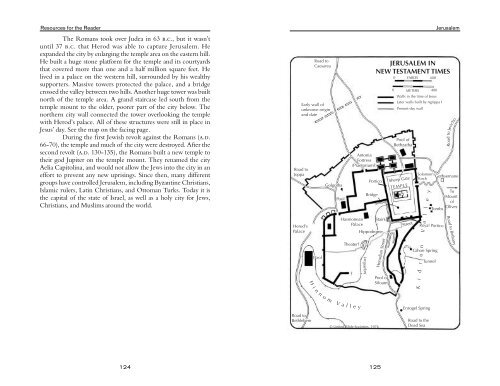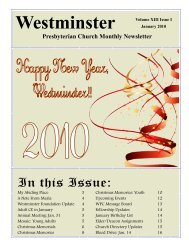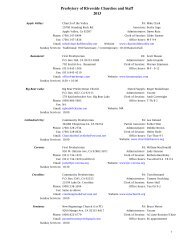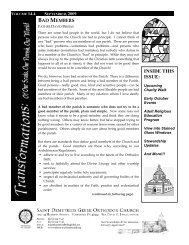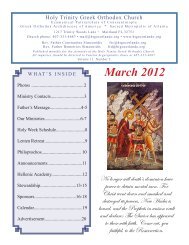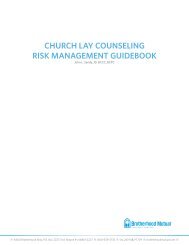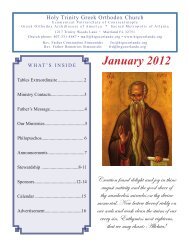The Life of the Christ - ForMinistry
The Life of the Christ - ForMinistry
The Life of the Christ - ForMinistry
You also want an ePaper? Increase the reach of your titles
YUMPU automatically turns print PDFs into web optimized ePapers that Google loves.
Resources for <strong>the</strong> Reader<br />
<strong>The</strong> Romans took over Judea in 63 b.c., but it wasn’t<br />
until 37 b.c. that Herod was able to capture Jerusalem. He<br />
expanded <strong>the</strong> city by enlarging <strong>the</strong> temple area on <strong>the</strong> eastern hill.<br />
He built a huge stone platform for <strong>the</strong> temple and its courtyards<br />
that covered more than one and a half million square feet. He<br />
lived in a palace on <strong>the</strong> western hill, surrounded by his wealthy<br />
supporters. Massive towers protected <strong>the</strong> palace, and a bridge<br />
crossed <strong>the</strong> valley between two hills. Ano<strong>the</strong>r huge tower was built<br />
north <strong>of</strong> <strong>the</strong> temple area. A grand staircase led south from <strong>the</strong><br />
temple mount to <strong>the</strong> older, poorer part <strong>of</strong> <strong>the</strong> city below. <strong>The</strong><br />
nor<strong>the</strong>rn city wall connected <strong>the</strong> tower overlooking <strong>the</strong> temple<br />
with Herod’s palace. All <strong>of</strong> <strong>the</strong>se structures were still in place in<br />
Jesus’ day. See <strong>the</strong> map on <strong>the</strong> facing page.<br />
During <strong>the</strong> first Jewish revolt against <strong>the</strong> Romans (a.d.<br />
66-70), <strong>the</strong> temple and much <strong>of</strong> <strong>the</strong> city were destroyed. After <strong>the</strong><br />
second revolt (a.d. 130-135), <strong>the</strong> Romans built a new temple to<br />
<strong>the</strong>ir god Jupiter on <strong>the</strong> temple mount. <strong>The</strong>y renamed <strong>the</strong> city<br />
Aelia Capitolina, and would not allow <strong>the</strong> Jews into <strong>the</strong> city in an<br />
effort to prevent any new uprisings. Since <strong>the</strong>n, many different<br />
groups have controlled Jerusalem, including Byzantine <strong>Christ</strong>ians,<br />
Islamic rulers, Latin <strong>Christ</strong>ians, and Ottoman Turks. Today it is<br />
<strong>the</strong> capital <strong>of</strong> <strong>the</strong> state <strong>of</strong> Israel, as well as a holy city for Jews,<br />
<strong>Christ</strong>ians, and Muslims around <strong>the</strong> world.<br />
124<br />
Road to<br />
Caesarea<br />
Early wall <strong>of</strong><br />
unknown origin<br />
and date<br />
Road to<br />
Joppa<br />
Herod's<br />
Palace<br />
Pool<br />
H i n n o<br />
Golgotha<br />
Pool<br />
m V a l l e y<br />
Antonia<br />
Fortress<br />
(Praetorium?)<br />
Hasmonean<br />
Palace<br />
<strong>The</strong>ater?<br />
?<br />
Hippodrome<br />
JERUSALEM IN<br />
NEW TESTAMENT TIMES<br />
0 YARDS 400<br />
0 METERS 400<br />
Walls in <strong>the</strong> time <strong>of</strong> Jesus<br />
Later walls built by Agrippa I<br />
Present-day wall<br />
Road to<br />
Bethlehem Road to <strong>the</strong><br />
© United Bible Societies, 1976<br />
Dead Sea<br />
Aqueduct<br />
Portico<br />
Bridge<br />
Stairs<br />
Herodian Street<br />
Pool <strong>of</strong><br />
Siloam<br />
125<br />
Pool <strong>of</strong><br />
Bethzatha<br />
Sheep Gate<br />
TEMPLE<br />
Street<br />
Road to Jericho<br />
Solomon's<br />
Gethsemane<br />
Porch<br />
Tombs<br />
Royal Portico<br />
Gihon Spring<br />
Tunnel<br />
K i d r o n V a l l e y<br />
Enrogel Spring<br />
Jerusalem<br />
To<br />
Mount<br />
<strong>of</strong><br />
Olives<br />
Road to Bethany


